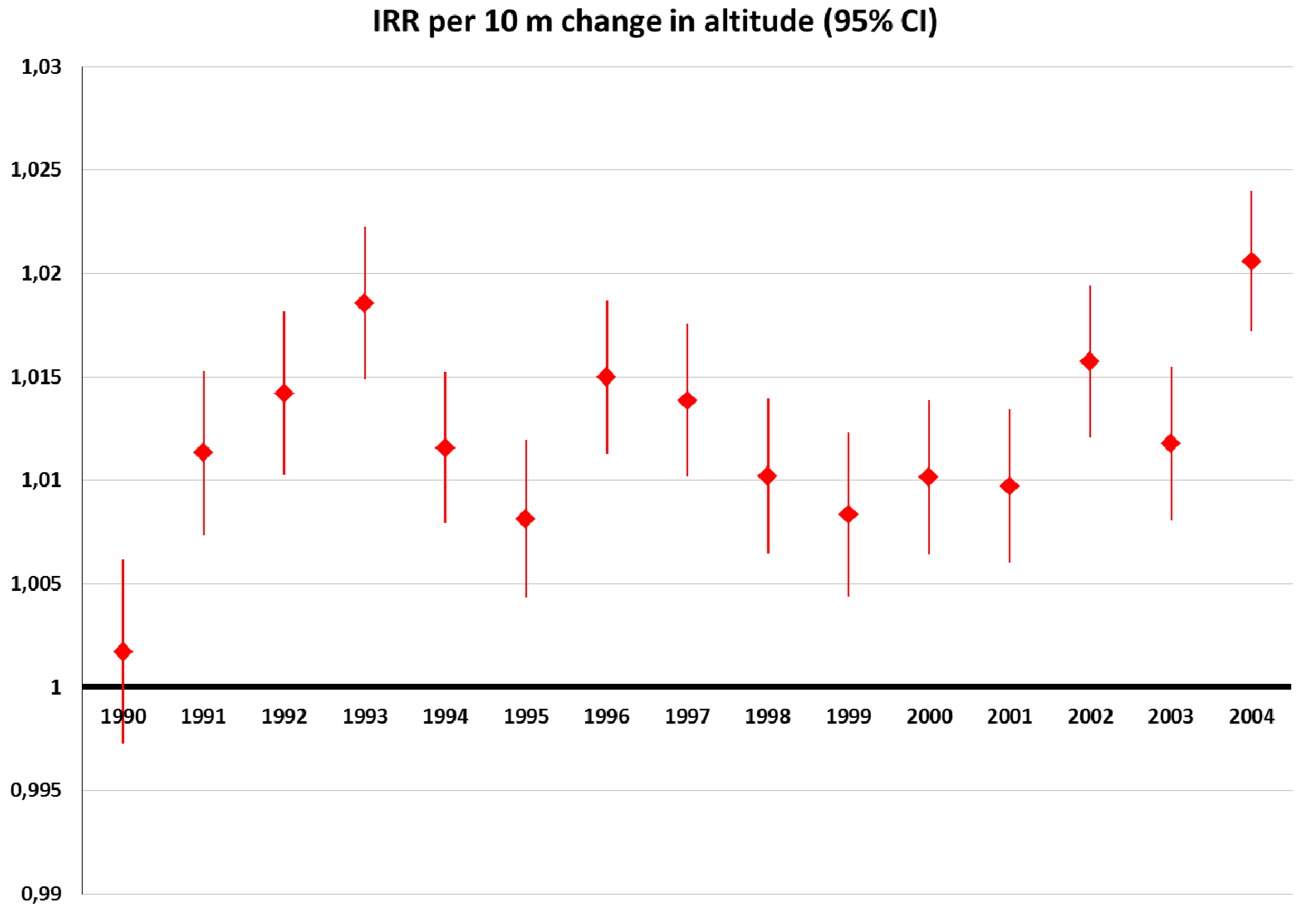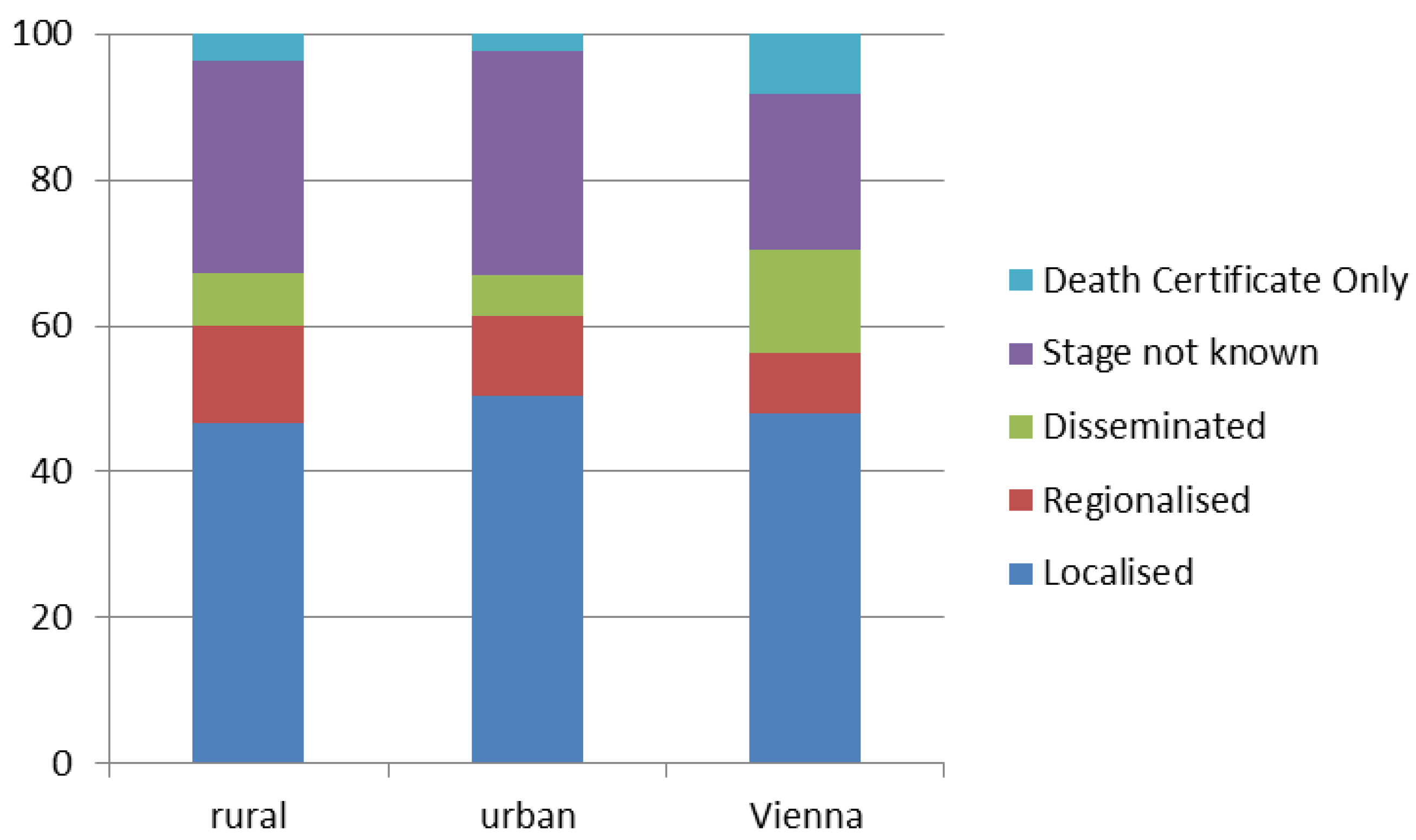Temporal and Spatial Melanoma Trends in Austria: An Ecological Study
Abstract
:1. Instruction
2. Experimental Section
2.1. Melanoma Data
2.2. Age-adjustment
2.3. Independent Factors
2.4. Regression Models
3. Results





| Men | Women | |||
|---|---|---|---|---|
| Factor | MRR | 95% CI | MRR | 95% CI |
| Per year | 1.010 | 1.008–1.013 | 1.013 | 1.011–1.016 |
| Per meter | 0.9996 | 0.9994–0.9998 | 0.9993 | 0.9991–0.9995 |
| Urban vs. Rural | 1.167 | 1.074–1.268 | 1.195 | 1.100–1.300 |
| Vienna vs. Rural | 1.206 | 1.109–1.313 | 1.247 | 1.149–1.354 |
4. Discussion
4.1. The Discrepancy between Incidence and Mortality

4.2. Implications for Climate Change-Related Health Impact Assessment
5. Conclusions
Acknowledgments
Conflicts of Interest
References
- The International Agency for Research on Cancer Working Group on Artificial Ultraviolet (UV) Light and Skin Cancer (IARC). Exposure to Artificial UV Radiation and Skin Cancer. IARC Working Group Reports; IARC: Lyon, France, 2005; Volume 1. [Google Scholar]
- The international agency for research on cancer working group on artificial ultraviolet (UV) light and skin cancer (IARC). The association of use of sunbeds with cutaneous malignant melanoma and other skin cancers: A systematic review. Int. J. Cancer 2007, 120, 1116–1122. [Google Scholar]
- Veierod, M.B.; Adami, H.O.; Lund, E.; Armstrong, B.K.; Weiderpass, E. Sun and solarium exposure and melanoma risk: Effects of age, pigmentary characteristics, and nevi. Cancer Epidem. Biomarker. Prev. 2010, 19, 111–120. [Google Scholar] [CrossRef]
- Dal, H.; Boldemann, C.; Lindelof, B. Does relative melanoma distribution by body site 1960–2004 reflect changes in intermittent exposure and intentional tanning in the Swedish population? Eur. J. Dermatol. 2007, 17, 428–434. [Google Scholar]
- Kricker, A.; Armstrong, B.K.; Goumas, C.; Kanetsky, P.; Gallagher, R.P.; Begg, C.B.; Millikan, R.C.; Dwyer, T.; Rosso, S.; Marrett, L.D.; et al. Mc1r genotype may modify the effect of sun exposure on melanoma risk in the GEM study. Cancer Cause. Control 2010, 21, 2137–2147. [Google Scholar] [CrossRef]
- Fortes, C.; Mastroeni, S.; Boffetta, P.; Innocenzi, L.; Antonelli, G.; Giovinazzo, R.; Anzidei, P.; Melchi, F.; D’Atri, S.; Pasquini, P.; et al. Polymorphisms of GSTM1 and GSTT1, sun exposure and the risk of melanoma: A case-control study. Acta. Dermato-Venereol. 2011, 91, 284–289. [Google Scholar] [CrossRef]
- Clarke, C.A.; Moy, L.M.; Swetter, S.M.; Zadnick, J.; Cockburn, M.G. Interaction of area-level socioeconomic status and UV radiation on melanoma occurrence in California. Cancer Epidem. Biomarker. Prev. 2010, 19, 2727–2733. [Google Scholar] [CrossRef]
- The International Agency for Research on Cancer Working Group on Artificial Ultraviolet (UV) Light and Skin Cancer (IARC). Solar and Ultraviolet Radiation. IARC Monographs; IARC: Lyon, France, 1992; Volume 55. [Google Scholar]
- Haluza, D.; Cervinka, R. Perceived relevance of educative information on public (skin) health: A cross-sectional questionnaire survey. J. Prev. Med. Public Health 2013, 46, 82–88. [Google Scholar] [CrossRef]
- Sancho-Garnier, H.; Pereira, B.; Cesarini, P. A cluster randomized trial to evaluate a health education programme “living with sun at school”. Int J. Environ. Res. Public Health 2012, 9, 2345–2361. [Google Scholar] [CrossRef]
- O’Keefe, D.J.; Wu, D. Gain-framed messages do not motivate sun protection: A meta-analytic review of randomized trials comparing gain-framed and loss-framed appeals for promoting skin cancer prevention. Int J. Environ. Res. Public Health 2012, 9, 2121–2133. [Google Scholar] [CrossRef]
- Kasparian, N.A.; McLoone, J.K.; Meiser, B. Skin cancer-related prevention and screening behaviors: A review of the literature. J. Behav. Med. 2009, 32, 406–428. [Google Scholar] [CrossRef]
- Glanz, K.; Yaroch, A.L.; Dancel, M.; Saraiya, M.; Crane, L.A.; Buller, D.B.; Manne, S.; O’Riordan, D.L.; Heckman, C.J.; Hay, J.; et al. Measures of sun exposure and sun protection practices for behavioral and epidemiologic research. Arch. Dermatol. 2008, 144, 217–222. [Google Scholar]
- Oliveria, S.A.; Saraiya, M.; Geller, A.C.; Heneghan, M.K.; Jorgensen, C. Sun exposure and risk of melanoma. Arch. Dis. Child. 2006, 91, 131–138. [Google Scholar]
- O’Rorke, M.A.; Black, C.; Murray, L.J.; Cardwell, C.R.; Gavin, A.T.; Cantwell, M.M. Do perinatal and early life exposures influence the risk of malignant melanoma? A northern Ireland birth cohort analysis. Eur. J. Cancer 2013, 49, 1109–1116. [Google Scholar] [CrossRef]
- Liu, F.; Bessonova, L.; Taylor, T.H.; Ziogas, A.; Meyskens, F.L., Jr.; Anton-Culver, H. A unique gender difference in early onset melanoma implies that in addition to ultraviolet light exposure other causative factors are important. Pigment Cell Melanoma Res. 2013, 26, 128–135. [Google Scholar] [CrossRef]
- Lemus-Deschamps, L.; Makin, J.K. Fifty years of changes in UV index and implications for skin cancer in Australia. Int. J. Biometeorol. 2012, 56, 727–735. [Google Scholar] [CrossRef]
- Medhaug, I.; Olseth, J.A.; Reuder, J. UV radiation and skin cancer in Norway. J. Photochem. Photobiol. B 2009, 96, 232–241. [Google Scholar] [CrossRef]
- Den Outer, P.N.; Slaper, H.; Kaurola, J.; Lindfors, A.; Kazantzidis, A.; Bais, A.F.; Feister, U.; Junk, J.; Janouch, M.; Josefsson, W. Reconstructing of erythemal ultraviolet radiation levels in Europe for the past 4 decades. J. Geophys. Res.-Atmos. 2010. [Google Scholar] [CrossRef]
- Van Dijk, A.; Slaper, H.; den Outer, P.N.; Morgenstern, O.; Braesicke, P.; Pyle, J.A.; Garny, H.; Stenke, A.; Dameris, M.; Kazantzidis, A.; et al. Skin cancer risks avoided by the Montreal protocol—Worldwide modeling integrating coupled climate-chemistry models with a risk model for UV. Photochem. Photobiol. 2013, 89, 234–246. [Google Scholar] [CrossRef]
- Martinez-Lozano, J.A.; Utrillas, M.P.; Nunez, J.A.; Tamayo, J.; Marin, M.J.; Esteve, A.R.; Canadad, J.; Moreno, J.C. Ozone mini-holes over Valencia (Spain) and their influence on the UV erythemal radiation. Int. J. Climatol. 2011, 31, 1554–1566. [Google Scholar] [CrossRef]
- Stebel, K.; Hansen, G.H.; Edvardsen, K.; Gausa, M.; Lyngra, R.; Bekkelund, K.; Hoppe, U.P. Winter 2002/2003 above Northern Scandinavia Seen by the Alomar Ozone Dial: Ozone Mini-holes and Strong Psus. In proceedings of 22nd International Laser Radar Conference (ILRC 2004), Matera, Italy, 12–16 July 2004.
- Luk’yanova, N.F.; Lyudchik, A.M. Statistics of anomalous events in the ozonosphere over Europe. Russ. Meteorol. Hydrol. 2008, 33, 491–498. [Google Scholar] [CrossRef]
- Serrano, M.A.; Canada, J.; Moreno, J.C. Members of the Valencia Solar Radiation Research. Erythemal ultraviolet solar radiation doses received by young skiers. Photochem. Photobiol. Sci. 2013, 11, 1976–1983. [Google Scholar]
- Andersen, P.A.; Buller, D.B.; Walkosz, B.J.; Scott, M.D.; Maloy, J.A.; Cutter, G.R.; Dignan, M.D. Environmental cues to UV radiation and personal sun protection in outdoor winter recreation. Arch. Dermatol. 2010, 146, 1241–1247. [Google Scholar]
- Zielonke, N. Krebsinzidenz und Krebsmortalität in Österreich (Cancer incidence and cancer mortality in Austria); Statistik Austria: Wien, Austria, 2012. [Google Scholar]
- Liu, T.P.; Soong, S.J. Epidemiology of malignant melanoma. Surg Clin. N. Amer. 1996, 76, 1205–1222. [Google Scholar] [CrossRef]
- Margo, C.E.; Duncan, W.C.; Rich, A.; Garcia, E.; Stricker, J. Periocular cutaneous melanoma arising in a radiotherapy field. Ophthal. Plast. Reconstr. Surg. 2004, 20, 319–320. [Google Scholar] [CrossRef]
- Ribero, S.; Grassi, M.; Caliendo, V.; Lauro, D.; Macripo, G. Melanoma arising on a scar 10 years after a burn management and review of the literature. Ann. Plast. Surg. 2012, 69, 27–29. [Google Scholar] [CrossRef]
- Silvers, W.K.; Mintz, B. Differences in latency and inducibility of mouse skin melanomas depending on the age and anatomic site of the skin. Cancer Res. 1998, 58, 630–632. [Google Scholar]
- Trefzer, U.; Voit, C.; Milling, A.; Audring, H.; Sterry, W. Malignant melanoma arising in a radiotherapy field: Report of two cases and review of the literature. Dermatology 2003, 206, 265–268. [Google Scholar] [CrossRef]
- Richtig, E.; Gerger, A.; Berghold, A.; Schwantzer, G.; Ott, A.; Kerl, H.; Smolle, J. Natural history of invasive cutaneous melanoma in Styria, Austria 2001–2003. J. Dtsch. Dermatol. Ges. 2007, 5, 293–299. [Google Scholar] [CrossRef]
- Richtig, E.; Berghold, A.; Schwantzer, G.; Ott, A.; Wolfelmaier, F.; Karner, B.; Ludwig, R.; Denk, H.; Stering, R.; Leitner, G.; et al. Clinical epidemiology of invasive cutaneous malignant melanoma in the Austrian province Styria in the years 2001–2003 and its relationship with local geographical, meteorological and economic data. Dermatology 2007, 214, 246–252. [Google Scholar] [CrossRef]
- Lee, C.; Collichio, F.; Ollila, D.; Moschos, S. Historical review of melanoma treatment and outcomes. Clin. Dermatol. 2013, 31, 141–147. [Google Scholar] [CrossRef]
- Anderson, W.F.; Pfeiffer, R.M.; Tucker, M.A.; Rosenberg, P.S. Divergent cancer pathways for early-onset and late-onset cutaneous malignant melanoma. Cancer 2009, 115, 4176–4185. [Google Scholar] [CrossRef]
- Urbach, F. Ultraviolet radiation and skin cancer of humans. J. Photochem. Photobiol. B 1997, 40, 3–7. [Google Scholar] [CrossRef]
- Urbach, F. Potential health-effects of climatic-change—Effects of increased ultraviolet-radiation on man. Environ. Health Perspect. 1991, 96, 175–176. [Google Scholar] [CrossRef]
- Urbach, F. Potential effects of altered solar ultraviolet-radiation on human-skin cancer. Photochem. Photobiol. 1989, 50, 507–513. [Google Scholar] [CrossRef]
- Kittler, H.; Binder, M.; Wolff, K.; Pehamberger, H. A ten-year analysis of demographic trends for cutaneous melanoma: Analysis of 2501 cases treated at the University Department of Dermatology in Vienna (1990–1999). Wien. Klin. Wochenschr. 2001, 113, 321–327. [Google Scholar]
- Godar, D.E.; Landry, R.J.; Lucas, A.D. Increased UVA exposures and decreased cutaneous vitamin D-3 levels may be responsible for the increasing incidence of melanoma. Med. Hypotheses 2009, 72, 434–443. [Google Scholar] [CrossRef]
- Surdu, S.; Fitzgerald, E.F.; Bloom, M.S.; Boscoe, F.P.; Carpenter, D.O.; Haase, R.F.; Gurzau, E.; Rudnai, P.; Koppova, K.; Fevotte, J.; et al. Occupational exposure to ultraviolet radiation and risk of non-melanoma skin cancer in a multinational European study. PLoS One 2013. [Google Scholar] [CrossRef]
- Shipman, A.R.; Clark, A.B.; Levell, N.J. Sunnier European countries have lower melanoma mortality. Clin. Exp. Dermatol. 2011, 36, 544–547. [Google Scholar] [CrossRef]
- Gandini, S.; Sera, F.; Cattaruzza, M.S.; Pasquini, P.; Picconi, O.; Boyle, P.; Melchi, C.F. Meta-analysis of risk factors for cutaneous melanoma: II. Sun exposure. Eur. J. Cancer 2005, 41, 45–60. [Google Scholar] [CrossRef]
- Lin, S.W.; Chen, W.; Fan, J.H.; Dawsey, S.M.; Taylor, P.R.; Qiao, Y.L.; Abnet, C.C. Prospective study of serum 25-hydroxyvitamin D concentration and mortality in a Chinese population. Amer. J. Epidemiol. 2012, 176, 1043–1050. [Google Scholar] [CrossRef]
- Lin, S.W.; Wheeler, D.C.; Park, Y.; Cahoon, E.K.; Hollenbeck, A.R.; Freedman, D.M.; Abnet, C.C. Prospective study of ultraviolet radiation exposure and risk of cancer in the United States. Int. J. Cancer 2012, 131, 1015–1023. [Google Scholar] [CrossRef]
- Grant, W.B.; Juzeniene, A.; Lagunova, Z.; Porojnicu, A.C.; Moan, J.E. Vitamin D levels in Norway may be inadequate to reduce risk of breast cancer. Int. J. Cancer 2011, 128, 2249–2250. [Google Scholar] [CrossRef]
- Grant, W.B.; Juzeniene, A.; Moan, J.E. Review article: Health benefit of increased serum 25(OH)d levels from oral intake and ultraviolet-B irradiance in the Nordic countries. Scand. J. Public Health 2011, 39, 70–78. [Google Scholar] [CrossRef]
- Gilaberte, Y.; Aguilera, J.; Carrascosa, J.M.; Figueroa, F.L.; de Gabriel, J.R.; Nagore, E. Vitamin D: Evidence and controversies. Actas Dermosifiliogr. 2011, 102, 572–588. [Google Scholar] [CrossRef]
- Seidler, A.M.; Bayoumi, A.M.; Goldstein, M.K.; Cruz, P.D.; Chen, S.C. Willingness to pay in dermatology: Assessment of the burden of skin diseases. J. Invest. Dermatol. 2012, 132, 1785–1790. [Google Scholar] [CrossRef]
- Gallagher, R.P.; Lee, T.K.; Bajdik, C.D.; Borugian, M. Ultraviolet radiation. Chronic Dis. Can. 2010, 29, S51–S68. [Google Scholar]
© 2014 by the authors; licensee MDPI, Basel, Switzerland. This article is an open access article distributed under the terms and conditions of the Creative Commons Attribution license (http://creativecommons.org/licenses/by/3.0/).
Share and Cite
Haluza, D.; Simic, S.; Moshammer, H. Temporal and Spatial Melanoma Trends in Austria: An Ecological Study. Int. J. Environ. Res. Public Health 2014, 11, 734-748. https://doi.org/10.3390/ijerph110100734
Haluza D, Simic S, Moshammer H. Temporal and Spatial Melanoma Trends in Austria: An Ecological Study. International Journal of Environmental Research and Public Health. 2014; 11(1):734-748. https://doi.org/10.3390/ijerph110100734
Chicago/Turabian StyleHaluza, Daniela, Stana Simic, and Hanns Moshammer. 2014. "Temporal and Spatial Melanoma Trends in Austria: An Ecological Study" International Journal of Environmental Research and Public Health 11, no. 1: 734-748. https://doi.org/10.3390/ijerph110100734
APA StyleHaluza, D., Simic, S., & Moshammer, H. (2014). Temporal and Spatial Melanoma Trends in Austria: An Ecological Study. International Journal of Environmental Research and Public Health, 11(1), 734-748. https://doi.org/10.3390/ijerph110100734







